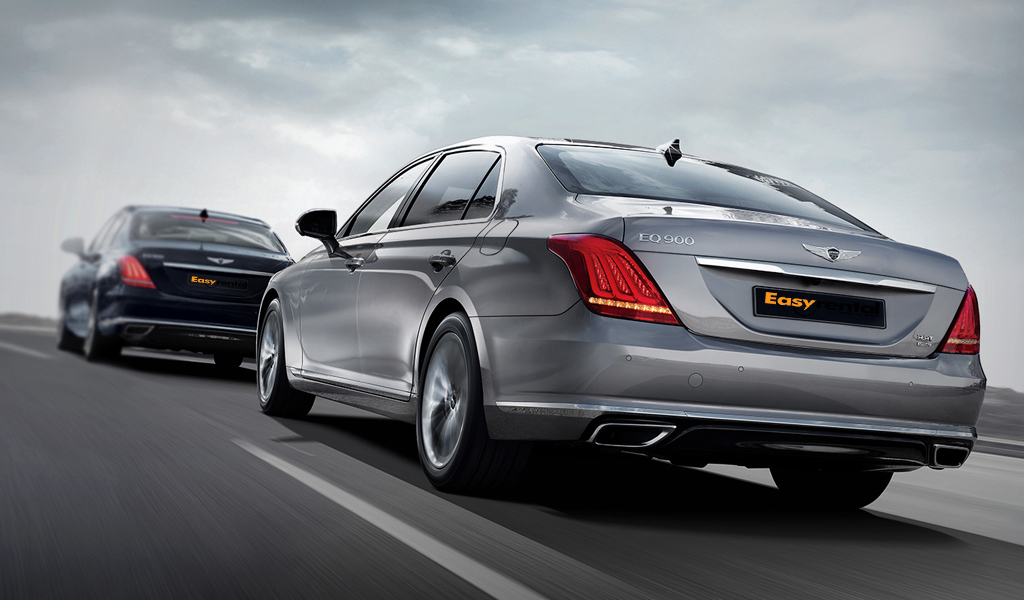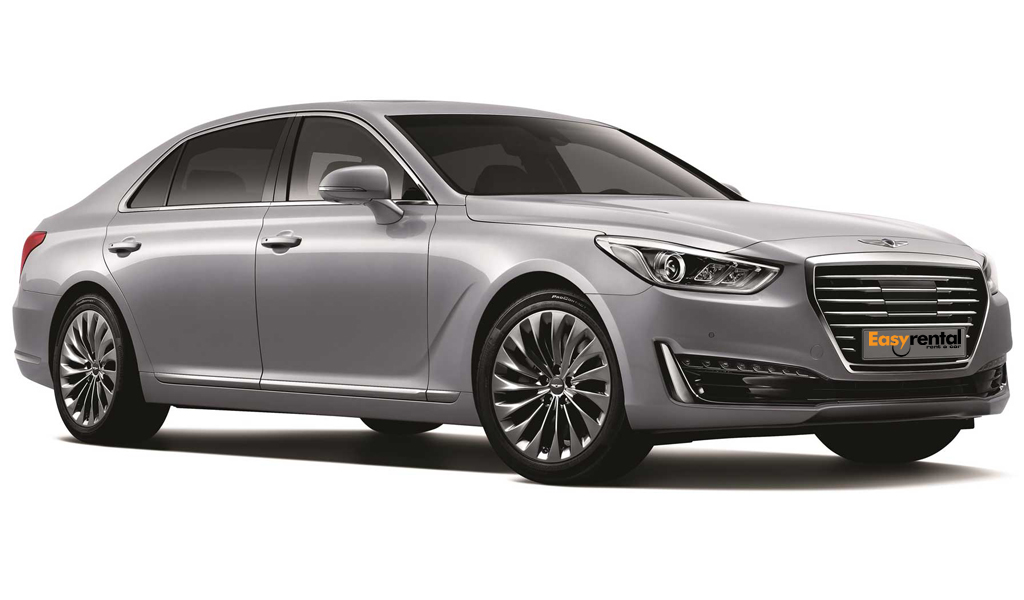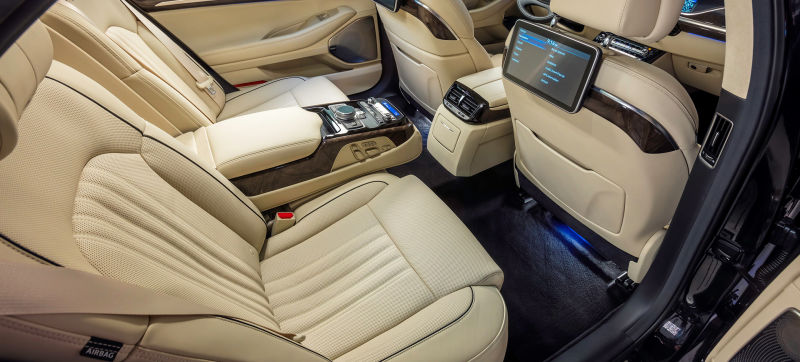�

In automotive terms, �Genesis� refers to the name of Hyundai�s new-for-2017 luxury brand, which has finally separated from its mothership and is striving for a Lexus-esque rise to prominence as it introduces five new models by 2021. The rechristening of the Hyundai Genesis sedan as the Genesis G80 was the Korean marque�s first platinum-plated stake in the turf, a fine starting point since it�s the best-driving Hyundai to date. But to properly establish Genesis as a true competitor to, say, Mercedes-Benz, a grand flagship was needed. Enter the 2017 G90 sedan, which presents as a solid yet decidedly simpler alternative to the established luxury liners.
Curb Your Enthusiasm
The fleet of G90s lining the curbs of our hotel in downtown Vancouver, British Columbia, exuded a swanky presence fit for a cadre of visiting dignitaries. Long and low with flowing lines and rear-wheel-drive proportions, it is an elegant automobile, albeit a somewhat generic-looking one. Its design is clearly related to the smaller G80 but with a touch of Mercedes-Benz S-class to the rear haunches and taillights and a hint of Audi A8 in the blunt nose and the hexagon grille. With the winged Genesis badge affixed to the top of its fascia rather than placed prominently in the snout, the G90 gives off the nonspecific vibe of a startup�s PowerPoint presentation on what a big-dollar luxury car should look like.

And that look doesn�t change based on optional equipment, because, surprisingly, unlike every other luxury brand�s offerings, there is none. Genesis offers buyers just one style of 19-inch aluminum wheels with all-season tires, and color choices are limited to four grayscale hues as well as dark blue or brown, with either a black or a beige interior.
Few Choices
Given that all G90s come essentially loaded to the gills with creature comforts (the V-8 brings a few additional items), buyers� preferences pertain only to the mechanicals. The bulk of our mostly highway driving was spent in the volume 3.3T Premium model, which features Hyundai�s latest iteration of the direct-injected Lambda V-6. Updates include the addition of twin turbochargers, along with downsizing to 3.3 liters of displacement from the naturally aspirated version�s 3.8. While not as silky as BMW�s turbocharged inline-six, the G90�s base V-6 engine is generally smooth and subdued and produces a hearty 365 horsepower at 6000 rpm. More important, its 376 lb-ft of torque from 1300 rpm affords whip-snap throttle response and satisfying thrust with every provocation of the accelerator pedal. Never did the V-6 feel labored in moving the G90�s nearly 5000 pounds.
Stepping up to the 5.0 Ultimate trim brings Hyundai�s buttery-smooth 5.0-liter Tau V-8 also found in the G80 and the G90�s predecessor, the Hyundai Equus. While our seat time in the Ultimate was minimal, the V-8�s refined snarl is a classic fit for a big luxury car, and there�s an even stronger kick from its 420 horsepower and 383 lb-ft of torque. We�ve recorded a solid 5.2-second zero-to-60-mph run from the similarly sized Equus with the Tau V-8, and G90s with the new V-6 shouldn�t be too far off that pace, either.
Hyundai�s eight-speed automatic, designed in-house, is the only transmission choice regardless of engine. It comes complete with a de rigueur electronic joystick shift lever and steering-wheel-mounted paddles that respond lazily to inputs. Gearchanges happen smoothly and with little fuss, even if upshifts come a bit too quickly at times. Rear-wheel drive is standard on the G90, but a rear-biased all-wheel-drive system, which Hyundai calls H-Trac, can be ordered with either powerplant. Whether rear- or all-wheel drive, the V-6 is rated at a modest 17 mpg city and 24 mpg highway. Opting for the rear-drive V-8 carries a 1-mpg penalty in the city cycle, with all-wheel drive further downgrading the V-8�s figures to 15/23 mpg.
Composed Comfort
Based on an enlarged version of the G80�s platform, the G90 measures within a couple of inches of its long-wheelbase competitors in overall dimensions, including the Mercedes-Benz S-class and the Audi A8 as well as the BMW 7-series, the Cadillac CT6, and the Lexus LS. This big car benefits from having a host of cameras to aid tight parking maneuvers. Genesis claims the G90�s steel structure is lighter and stiffer than the S-class�s body-in-white. But this is no lightweight, with aluminum used only for some suspension components. The smooth Canadian roads meant there were no opportunities to experience any serious impact harshness, but the car generally feels composed and far more rigid than the previous Equus.
![]()
Genesis didn�t outsource the G90�s ride-and-handling development to Lotus Engineering, as was done with the G80, yet it has refined its own tuning to provide a similar sense of competence. Brake feel is satisfyingly firm and responsive, body motions are kept nicely in check, and the electrically assisted steering is relatively hefty, with secure on-center tracking and a modicum of feedback. The standard driver-adjustable Sachs/ZF dampers vary ride quality from cushy to somewhat flinty, but the car never wallows or crashes on its bump stops.
Notable only for its inoffensiveness, the G90�s driving behavior is best enjoyed at a modest pace. A button on the center console selects one of four drive modes (Smart, Sport, Eco, and Individual), which change the car�s character from relaxed to slightly energized by adjusting the firmness of the dampers and the steering, the aggressiveness of the throttle and the transmission programming, and even the bias of the all-wheel-drive system. We found the default Smart setting to be the best, its programmed logic adapting to our throttle inputs for a happy medium between the lethargic Eco and the harsher Sport mode.
The Kitchen Sink
�

The G90�s stately cabin is a model of sound suppression, offering lots of room to stretch out and configurable mood lighting for ambiance. A power sunroof, a faux-suede headliner, and supple leather on the dash, doors, and seats all are included, as are real wood, aluminum, and stainless-steel trim. The four outboard seats are heated and ventilated (the latter only in the V-8) as well as eminently comfortable and supportive, particularly the 22-way-adjustable driver�s throne. There are also nine airbags, power soft-close doors, a wireless charging pad for personal devices, a 7.0-inch information screen between the main analog gauges, a vivid 12.3-inch central display with an intuitive menu layout, and a 17-speaker Lexicon audio system. The only upgrades come with the V-8�s Ultimate trim level, which swaps the V-6�s bixenon headlights for LEDs and adds power adjustability and ventilation for the outboard rear seating positions.






